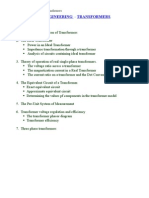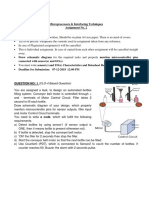Faraday Law of Electromagnetic Induction
Faraday Law of Electromagnetic Induction
Uploaded by
antex nebyuCopyright:
Available Formats
Faraday Law of Electromagnetic Induction
Faraday Law of Electromagnetic Induction
Uploaded by
antex nebyuOriginal Description:
Original Title
Copyright
Available Formats
Share this document
Did you find this document useful?
Is this content inappropriate?
Copyright:
Available Formats
Faraday Law of Electromagnetic Induction
Faraday Law of Electromagnetic Induction
Uploaded by
antex nebyuCopyright:
Available Formats
Faraday Law of Electromagnetic
Induction
Show/Hide Page Index
In 1831, Michael Faraday, an English physicist gave one of the
most basic laws of electromagnetism called Faraday's law of
electromagnetic induction. This law explains the working
principle of most of theelectrical motors, generators, electrical
transformers and inductors . This law shows the relationship
between electric circuit and magnetic field. Faraday performs an
experiment with a magnet and coil. During this experiment, he
found how emf is induced in the coil when flux linked with it
changes. He has also done experiments in electro-chemistry and
electrolysis.
Faraday's Experiment
RELATIONSHIP BETWEEN INDUCED EMF AND FLUX
In this experiment, Faraday
takes a magnet and a coil and connects a galvanometer across
the coil. At starting, the magnet is at rest, so there is no
deflection in the galvanometer i.e needle of galvanometer is at
the center or zero position. When the magnet is moved towards
the coil, the needle of galvanometer deflects in one direction.
When the magnet is held stationary at that position, the needle of
galvanometer returns back to zero position. Now when the
magnet is moved away from the coil, there is some deflection in
the needle but in opposite direction and again when the magnet
becomes stationary, at that point with respect to coil, the needle
of the galvanometer returns back to the zero position. Similarly, if
magnet is held stationary and the coil is moved away and towards
the magnet, the galvanometer shows deflection in similar
manner. It is also seen that, the faster the change in the
magnetic field, the greater will be the induced emf or voltage in
the coil.
Position of magnet
Deflection in galvanome
Magnet at rest
No deflection in galv
Magnet moves towards the coil
Deflection in galvano
Magnet is held stationary at same position (near the
coil)
No deflection in galv
Magnet moves away from the coil
Deflection in galvano
direction
Magnet is held stationary at same position (away from
No deflection in galv
the coil)
CONCLUSION: From this experiment, Faraday concluded
that whenever there is relative motion between conductor
and a magnetic field, the flux linkage with a coil changes
and this change in flux induces a voltage across a coil.
Michael Faraday formulated two laws on the basis of above
experiments. These laws are called Faraday's laws of
electromagnetic induction.
Faraday's Laws
Faraday's First Law
Any change in the magnetic field of a coil of wire will cause an
emf to be induced in the coil. This emf induced is called induced
emf and if the conductor circuit is closed, the current will also
circulate through the circuit and this current is called induced
current. Method to change magnetic field: 1. By moving a magnet
towards or away from the coil 2. By moving the coil into or out of
the magnetic field. 3. By changing the area of a coil placed in the
magnetic field 4. By rotating the coil relative to the magnet.
Faraday's Second Law
It states that the magnitude of emf induced in the coil is equal to
the rate of change of flux that linkages with the coil. The flux
linkage of the coil is the product of number of turns in the coil
and flux associated with the coil.
Faraday Law Formula
Consider a magnet
approaching towards a coil. Here we consider two instants at time
T1 and time T2. Flux linkage with the coil at time, T1 = N1 Wb
Flux linkage with the coil at time, T2 = N2 wb Change in flux
linkage = N(2 - 1) Let this change in flux linkage be, = 2 1 So, the Change in flux linkage = N Now the rate of change of
flux linkage = N / t Take derivative on right hand side we will
get The rate of change of flux linkage = Nd/dt But according to
Faraday's law of electromagnetic induction, the rate of change of
flux linkage is equal to induced emf.
Considering Lenz's Law.
Where flux in Wb = B.A
B = magnetic field strength
A = area of the coil HOW TO INCREASE EMF INDUCED IN A
COIL
By increasing the number of turns in the coil i.e N- From the
formulae derived above it is easily seen that if number of turns of
coil is increased, the induced emf also gets increased.
By increasing magnetic field strength i.e B surrounding the coilMathematically if magnetic field increases, flux increases and if
flux increases emf induced will also get increased. Theoretically, if
the coil is passed through a stronger magnetic field, there will be
more lines of force for coil to cut and hence there will be more
emf induced.
By increasing the speed of the relative motion between the coil
and the magnet - If the relative speed between the coil and
magnet is increased from its previous value, the coil will cut the
lines of flux at a faster rate, so more induced emf would be
produced.
Applications of Faraday Law
Faraday law is one of the most basic and important laws of
electromagnetism . This law finds its application in most of the
electrical machines, industries and medical field etc.
Electrical Transformers It is a static ac device which is used to
either step up or step down voltage or current. It is used in
generating station, transmission and distribution system. The
transformer works on Faraday's law.
Electrical Generators The basic working principle of electrical
generator is Faraday's law of mutual induction. Electric generator
is used to convert mechanical energy into electrical energy.
Induction Cookers The Induction cooker, is a most fastest way
of cooking. It also works on principle of mutual induction. When
current flows through the coil of copper wire placed below a
cooking container, it produces a changing magnetic field. This
alternating or changing magnetic field induces an emf and hence
the current in the conductive container, and we know that flow of
current always produces heat in it.
Electromagnetic Flow Meters It is used to measure velocity of
blood and certain fluids. When a magnetic field is applied to
electrically insulated pipe in which conducting fluids are flowing,
then according to Faraday's law, an electromotive force is induced
in it. This induced emf is proportional to velocity of fluid flowing .
Form the bases of Electromagnetic Theory Faraday's idea of
lines of force is used in well known Maxwell's equations.
According to Faraday's law, change in magnetic field gives rise to
change in electric field and the converse of this is used in
Maxwell's equations.
Musical Instruments It is also used in musical instruments like
electric guitar, electric violin etc.
Faraday's Law-Video
Please provide your valuable comments
You might also like
- Ee 231 - Electric Circuits 1Document31 pagesEe 231 - Electric Circuits 1Kene LawNo ratings yet
- Lab 10 Polarization 2Document9 pagesLab 10 Polarization 2Prashant Gupta100% (1)
- Mixed Beds Regeneration - 45-D01129-EnDocument7 pagesMixed Beds Regeneration - 45-D01129-EnDFM100% (1)
- D076201Document21 pagesD076201ridazNo ratings yet
- La Comunidad JudiaDocument167 pagesLa Comunidad JudiaJorge Maduro100% (1)
- كتاب النبي دانيال PDFDocument22 pagesكتاب النبي دانيال PDFDemaa Naim75% (4)
- Differential AnalysisDocument26 pagesDifferential AnalysisEdma Glory Macadaag100% (1)
- BizTalk Development Best PracticesDocument25 pagesBizTalk Development Best PracticesAbdelfettah GasmiNo ratings yet
- SynopsisDocument12 pagesSynopsisGhazalpreet KaurNo ratings yet
- KVL KCLDocument6 pagesKVL KCLAllen WalkerNo ratings yet
- DC Motor Direction Control Using Power TriacDocument7 pagesDC Motor Direction Control Using Power TriacAshok KumarNo ratings yet
- Full Wave RectifierDocument5 pagesFull Wave Rectifierसूरज कुमार0% (1)
- ECE 2111 Lec PDFDocument51 pagesECE 2111 Lec PDFKenneth JameroNo ratings yet
- Assembler, Compiler, Loader and LinkerDocument5 pagesAssembler, Compiler, Loader and LinkerBrahmanand Singh100% (1)
- Transformers (ALL TOPICS)Document22 pagesTransformers (ALL TOPICS)Ramprakash100% (13)
- Basic Electrical LabDocument32 pagesBasic Electrical Labsrinu247No ratings yet
- Bab 1 - Alternating Voltage and CurrentDocument40 pagesBab 1 - Alternating Voltage and CurrentChinghing 2001No ratings yet
- TransistorDocument10 pagesTransistorLeunam SalpadNo ratings yet
- Electrical ProblemDocument8 pagesElectrical ProblemCheska FernandezNo ratings yet
- Solved Problems To Chapter 09Document4 pagesSolved Problems To Chapter 09REjosh BonifacioNo ratings yet
- Special Purpose DiodesDocument30 pagesSpecial Purpose DiodesSumi GargiNo ratings yet
- Types of ResistorDocument9 pagesTypes of ResistorManuel Panotes ReantazoNo ratings yet
- Rise Time Budget AnaylasesDocument16 pagesRise Time Budget Anaylasesmitaliswagh2002No ratings yet
- Remote Control For Toy CarDocument2 pagesRemote Control For Toy CarAriel MaubogNo ratings yet
- Energy Levels of Semiconductor, Conductors and InsulatorsDocument53 pagesEnergy Levels of Semiconductor, Conductors and InsulatorsTawki BakiNo ratings yet
- CIRCUITS 1 - Lab Experiment #02Document5 pagesCIRCUITS 1 - Lab Experiment #02jeryl generalaoNo ratings yet
- DC GeneratorDocument27 pagesDC GeneratorRahul BhandariNo ratings yet
- Lecture-13 - Conductivity and MobilityDocument4 pagesLecture-13 - Conductivity and MobilityDr. Deepak GuptaNo ratings yet
- Electromagnetic Induction ExperimentDocument3 pagesElectromagnetic Induction ExperimentnatlasNo ratings yet
- DC Motor and GeneratorDocument5 pagesDC Motor and GeneratorMousumiNo ratings yet
- What Is Alternating CurrentDocument49 pagesWhat Is Alternating CurrentRajeev ValunjkarNo ratings yet
- Full Wave Bridge RectifierDocument8 pagesFull Wave Bridge RectifierAnonimen AnonimenNo ratings yet
- Wireless Communication With Arduino Uno BoardDocument3 pagesWireless Communication With Arduino Uno BoardDan M Stone100% (1)
- Chapter 3 - Describing Logic Circuits - Dr. XuDocument86 pagesChapter 3 - Describing Logic Circuits - Dr. XuTimothy Ivan YosepNo ratings yet
- EEC 124 Electronics 1 Lecture Note by Engr A Ojo WilliamsDocument42 pagesEEC 124 Electronics 1 Lecture Note by Engr A Ojo Williamshusaja mohammedNo ratings yet
- Forouzan Digital Communications and NetworkingDocument13 pagesForouzan Digital Communications and NetworkingJaypeeUretaNo ratings yet
- Dot Matrix Led DisplayDocument6 pagesDot Matrix Led DisplayDipesh PatelNo ratings yet
- BLUED: A Fully Labeled Public Dataset For Event-Based Non-Intrusive Load Monitoring ResearchDocument5 pagesBLUED: A Fully Labeled Public Dataset For Event-Based Non-Intrusive Load Monitoring ResearchChirag SharmaNo ratings yet
- Windows XP Boot SequenceDocument1 pageWindows XP Boot SequenceNitin BelgaonkarNo ratings yet
- The Basic Principles of ElectricityDocument37 pagesThe Basic Principles of ElectricityCris Yirah DaclanNo ratings yet
- EXPERIMENT NO 1 Electrical Circuits LaboratoryDocument19 pagesEXPERIMENT NO 1 Electrical Circuits LaboratoryJely Taburnal Bermundo100% (1)
- Acs Schematic DiagramDocument1 pageAcs Schematic DiagramYOGESH SONINo ratings yet
- Code Division MultiplexingDocument1 pageCode Division Multiplexingx3b0No ratings yet
- The InductorDocument25 pagesThe InductorSureshraja9977No ratings yet
- Lab Report On 5v Regulated Power Supply: Md. Tariq HasanDocument9 pagesLab Report On 5v Regulated Power Supply: Md. Tariq HasanRounok100% (1)
- All Emft NotesDocument89 pagesAll Emft Notestony kimaniNo ratings yet
- Electrical Principles 2 (CCEET 2)Document25 pagesElectrical Principles 2 (CCEET 2)Bernard MunyithyaNo ratings yet
- Principles of Electricity: Background To Electricity, Circuits, and How To CalculateDocument22 pagesPrinciples of Electricity: Background To Electricity, Circuits, and How To CalculatetuNo ratings yet
- Compound Bar LECTURE 14Document5 pagesCompound Bar LECTURE 14Zein Elserfy100% (1)
- Network ManagementDocument30 pagesNetwork ManagementSaravanan Nallusamy100% (2)
- Networking: PPT Requirement For Students As AprojectDocument22 pagesNetworking: PPT Requirement For Students As Aproject10chirag10100% (1)
- Basic Electronics NotesDocument114 pagesBasic Electronics Notessmrutirekha100% (1)
- Three PhaseDocument29 pagesThree PhaseBaquiran John Paul BaquiranNo ratings yet
- On Michael Farady by Aarushi PatidarDocument20 pagesOn Michael Farady by Aarushi PatidarAarushi Patidar100% (1)
- DC Circuit TheoryDocument81 pagesDC Circuit TheoryAbdullah Al AsikNo ratings yet
- FM Receiver JournalDocument3 pagesFM Receiver JournalRichardNo ratings yet
- Osi NotesDocument11 pagesOsi Notesvardhini rudraNo ratings yet
- Microprocessors & Interfacing Techniques Assignment No. 2Document2 pagesMicroprocessors & Interfacing Techniques Assignment No. 2Abdullah Nasir100% (4)
- Faraday's Electeomagnetic Induction.Document5 pagesFaraday's Electeomagnetic Induction.Rajesh JagadeesanNo ratings yet
- FaradayDocument14 pagesFaradayVarad KakodkarNo ratings yet
- Elmachi1 - Lecture6 (Electrical Machines - Part 1)Document17 pagesElmachi1 - Lecture6 (Electrical Machines - Part 1)Trisha SARMIENTONo ratings yet
- Electromagnetic Induction ExplainedDocument3 pagesElectromagnetic Induction ExplainedAli HamzaNo ratings yet
- Faraday's LawDocument5 pagesFaraday's LawSyeda Rutab AzizNo ratings yet
- Physics Faraday ProjectDocument16 pagesPhysics Faraday ProjectAlviya Rizwan100% (1)
- Self Check1Document1 pageSelf Check1antex nebyuNo ratings yet
- Kundur DTS Chap5Document10 pagesKundur DTS Chap5antex nebyuNo ratings yet
- LQG LTR Controller Design For An Aircraft ModelDocument12 pagesLQG LTR Controller Design For An Aircraft Modelantex nebyuNo ratings yet
- Ethiopian TVET-System: Learning Guide # 3Document17 pagesEthiopian TVET-System: Learning Guide # 3antex nebyuNo ratings yet
- Frequency Domain Analysis of SystemsDocument56 pagesFrequency Domain Analysis of Systemsantex nebyuNo ratings yet
- Lap Test Practical DemonstrationDocument1 pageLap Test Practical Demonstrationantex nebyuNo ratings yet
- L03-Key Answers: Self Check 1Document1 pageL03-Key Answers: Self Check 1antex nebyuNo ratings yet
- Self-Check 2Document1 pageSelf-Check 2antex nebyuNo ratings yet
- Lap Test Practical DemonstrationDocument2 pagesLap Test Practical Demonstrationantex nebyuNo ratings yet
- Self Check 1Document1 pageSelf Check 1antex nebyuNo ratings yet
- Ethiopian TVET-System: Learning Guide # 2Document17 pagesEthiopian TVET-System: Learning Guide # 2antex nebyu100% (2)
- L02-Key Answers: Self Check 1Document2 pagesL02-Key Answers: Self Check 1antex nebyuNo ratings yet
- Self Check 2Document1 pageSelf Check 2antex nebyuNo ratings yet
- L01-Key Answers: Self Check 1:: 64-Bit (x64)Document1 pageL01-Key Answers: Self Check 1:: 64-Bit (x64)antex nebyuNo ratings yet
- Lap Test Practical DemonstrationDocument1 pageLap Test Practical Demonstrationantex nebyuNo ratings yet
- E Types of Electrical CircuitsDocument1 pageE Types of Electrical Circuitsantex nebyuNo ratings yet
- Quality Management ProjectDocument26 pagesQuality Management Projectantex nebyuNo ratings yet
- Assessment Packet WrittenDocument5 pagesAssessment Packet Writtenantex nebyuNo ratings yet
- Temperature Controlled FanDocument14 pagesTemperature Controlled Fanantex nebyuNo ratings yet
- 1 Chapter One Govt and NFPDocument27 pages1 Chapter One Govt and NFPantex nebyu100% (1)
- Self-Check 1 Written Test: Name: - Date: - 1. 2. 3Document1 pageSelf-Check 1 Written Test: Name: - Date: - 1. 2. 3antex nebyuNo ratings yet
- Process Control in Wet Tannery: The Block Diagram of The Process Can Be Interpreted AsDocument30 pagesProcess Control in Wet Tannery: The Block Diagram of The Process Can Be Interpreted Asantex nebyuNo ratings yet
- PDFDocument64 pagesPDFava-rezNo ratings yet
- Local Table 0920Document5 pagesLocal Table 0920inforumdocsNo ratings yet
- Report On O.N.G.C. Ltd. Mehsana: Mousumi K. MitraDocument4 pagesReport On O.N.G.C. Ltd. Mehsana: Mousumi K. Mitraashim1006No ratings yet
- E PaymentDocument22 pagesE PaymentxanshahNo ratings yet
- EULA Free Font License Ver. 2.0 PDFDocument2 pagesEULA Free Font License Ver. 2.0 PDFSion J SNo ratings yet
- VolvoDocument21 pagesVolvoRuiqing XieNo ratings yet
- Quadrofoil Manual Q2S 2019 ENG V1.2 InteractiveDocument59 pagesQuadrofoil Manual Q2S 2019 ENG V1.2 Interactivemjsw24121966No ratings yet
- Ra 6713Document25 pagesRa 6713Lucille MinaNo ratings yet
- Working CapitalDocument62 pagesWorking CapitalSahil SethiNo ratings yet
- Systematic Review of Probiotics For The Treatment of Community-Acquired Acute Diarrhea in ChildrenDocument8 pagesSystematic Review of Probiotics For The Treatment of Community-Acquired Acute Diarrhea in ChildrenSandraJSantosNo ratings yet
- Testing Best PracticeDocument14 pagesTesting Best PracticeAnanya BhagatNo ratings yet
- SOP For Gas CylindersDocument1 pageSOP For Gas CylindersVinod Gupta0% (1)
- Chap23 Measuring The Cost of LivingDocument85 pagesChap23 Measuring The Cost of LivingThanh Thư100% (1)
- Batik Air - PRATAMA MARHADI 26 JUNI 2023Document2 pagesBatik Air - PRATAMA MARHADI 26 JUNI 2023eko handoyoNo ratings yet
- Touch Sensor Project REPORTDocument25 pagesTouch Sensor Project REPORTKiran patil ROLL NO 55 D DIVNo ratings yet
- Advert For March 2024 Atswa ExaminationDocument3 pagesAdvert For March 2024 Atswa ExaminationniyiNo ratings yet
- Emergency Room Medicine - 4th EdDocument290 pagesEmergency Room Medicine - 4th EdBlitzen BusaingNo ratings yet
- Food We Eat Worksheet 2 PDFDocument1 pageFood We Eat Worksheet 2 PDFRabi Kumar PatraNo ratings yet
- Medals & Decoration: Police Medal For Meritorious ServiceDocument3 pagesMedals & Decoration: Police Medal For Meritorious ServicePraveen KumarNo ratings yet
- (Download PDF) Essentials of Radiology Common Indications and Interpretation 4Th Edition Mettler JR MD MPH Full Chapter PDFDocument69 pages(Download PDF) Essentials of Radiology Common Indications and Interpretation 4Th Edition Mettler JR MD MPH Full Chapter PDFkaciubobel100% (13)
- HKMagazine 07112014Document48 pagesHKMagazine 07112014apparition9No ratings yet
- Cashflow.comDocument40 pagesCashflow.comad9292No ratings yet
- Legal Department: Mr. Dexter R. RosalesDocument1 pageLegal Department: Mr. Dexter R. Rosalescolonjoseph1113No ratings yet
- RP 157Document33 pagesRP 157Vasant Kumar VarmaNo ratings yet
- DevOps Resume 81Document4 pagesDevOps Resume 81splunks159No ratings yet















































































































